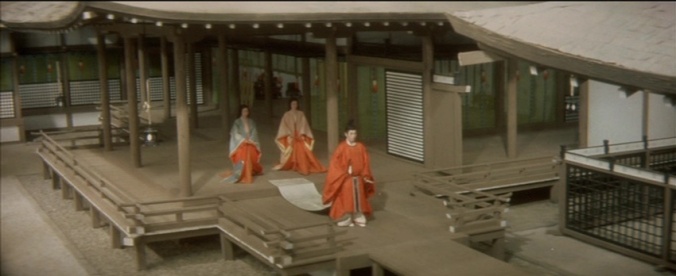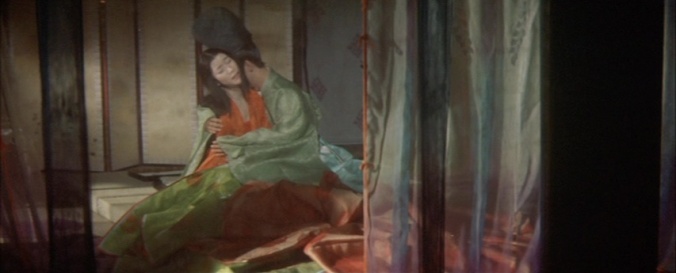 In movies as in life, you have to be careful what you wish for. When I saw the 1951 Genji monogatari, I thought “If only this were in color, and the leading man were not forty plus!” Shin Genji monogatari gives us a Genji of the right age, Raizo Ichikawa, and color plus widescreen. Unfortunately, they did not simply remake the 1951 film but wrote a new adaptation not by Tanizaki and Shindo and then gave it to Kazuo Mori rather than Yoshimura to direct. In the process, they managed to drain all the life out of the material and essentially turn it into a historical pageant.
In movies as in life, you have to be careful what you wish for. When I saw the 1951 Genji monogatari, I thought “If only this were in color, and the leading man were not forty plus!” Shin Genji monogatari gives us a Genji of the right age, Raizo Ichikawa, and color plus widescreen. Unfortunately, they did not simply remake the 1951 film but wrote a new adaptation not by Tanizaki and Shindo and then gave it to Kazuo Mori rather than Yoshimura to direct. In the process, they managed to drain all the life out of the material and essentially turn it into a historical pageant.
Murasaki’s novel is of course far too long and detailed to fit in a single film. As with the 1951 version, this focuses on Genji’s numerous affairs in his twenties, adding a couple that were left out of the earlier version as well as the story of his birth and of his eventual trip into exile. But somewhere along the way, Genji lost all his personality, however repulsive that might seem in some contemporary eyes. Women continue to throw themselves at him, but it is hard to see why. He is no longer the dashing roué and sportsman of the earlier version, for all of his other skills (except dancing) have disappeared from the story. Now, he is basically a mama’s boy trying to somehow sleep with his mother who died when he was born (a really intense Oedipus complex without the father portion).

Forbidden love
The most persistent of his loves is the Lady Fujitsubo, whom the Emperor has made his concubine because she reminds him of Genji’s dead mother, and once Genji hears this, he can’t wait to get into her bed. In 1951, this involved what we would now call a rape, but here it is merely a mild seduction to which she succumbs almost without resistance. He also has a long-running affair with a widow whom he has the gall to tell he needs her to be a mother’s shoulder to lean on (in between the sex, of course). Throw in three or four other women who almost literally drag him out of the hallway to get him into bed, and a “princess” whom he meets when stranded by a storm in the woods who starts to prepare for sex the moment she sees him.
The plot summary suggests at the very least a teasing sex romp, but the stately pace, Ichikawa’s unusually inexpressive face, and of course the lack of even the slightest hint of skin kill any hopes that such might have been the intention. I think, instead, we have that deadliest of all movie genres, the utterly respectful adaptation of a literary classic that makes most viewers wonder why they should even bother reading the original.
The long, flat architecture of the Imperial dwelling gives the widescreen images a sense of purity and elegance, but I think this is more an elegance forced upon the director and photographer than a real plan. Rarely do you get the sense of intentional artistic composition that ran through almost all the scenes of the 1951 film. The color, however, is fascinating. Art Director Yoshinobu Nishioka has taken as his model Gate of Hell, and we find the same reds and oranges and greens that made that film so striking. The available DVD lacks the intensity of the earlier feature, but this may simply be a fading of the original over the years. This is set in a historical era before the Japanese had developed the sliding screen, so rooms are often separated only by blinds or gauzy curtains, and even the standing screens are often only frames for loose strips of cloth. The costumes are in the same Chinese/Korean vein as the 1951 version but with a bit more prudery — while there are fewer layers of robes for the women, when they fall open we clearly see the Korean high-waisted skirt with an under-robe tucked into it to hide the breasts and shoulders. There is nothing even close to Machiko Kyo’s see-through bedroom scene.
The pageant-like approach to the story often makes it difficult to distinguish the women, at least in part because we are now a decade later and entering a time of less familiar faces. The one character to seem to have some real personality is Aoi, Genji’s legitimate wife, played by Ayako Wakao.
Given a bit more screen time than in the 1951 version, she is allowed to show her anger, jealousy, and dislike of her husband’s lifestyle and treatment of her, though the sentimental conversion to happy couple on her death bed rings as false and sappy as such scenes usually ring.
Even more than American movie makers, the Japanese were fond of remakes, especially of famous works of literature, so there will be many more opportunities to compare and contrast the various treatments of famous stories. (A brief glance at IMDB shows at least four more versions of Genji monogatari after this one, not counting TV.) Here, I think, unless you are a Raizo Ichikawa completist, there is little to grab your interest. If anything, it serves to make the superb 1951 version look even better.


Pingback: An Actor’s Revenge / Yukinojo henge (1959) | Japanonfilm
Pingback: Profound Desires of the Gods / Kamigami no fukaki yokubo (1968) | Japanonfilm
Pingback: Life of an Amorous Man / A Lustful Man / Koshoku ichidai otoko (1961) | Japanonfilm